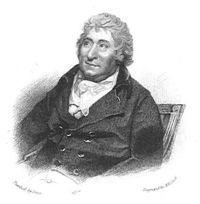Annotation:Dibdin's Fancy: Difference between revisions
No edit summary |
m (Text replacement - "garamond, serif" to "sans-serif") |
||
| Line 1: | Line 1: | ||
=='''Back to [[{{BASEPAGENAME}}]]'''== | =='''Back to [[{{BASEPAGENAME}}]]'''== | ||
---- | ---- | ||
<p><font face=" | <p><font face="sans-serif" size="4"> | ||
'''DIBDIN'S FANCY'''. English, Country Dance Tune (2/4 time). D Major (Rook): A Major (Thompson). Standard tuning (fiddle). AABB. Versions appear in print in several publications, including Samuel, Ann & Peter Thompson's '''Twenty Four Country Dances for the Year 1791''' (London), '''Riley's Flute Melodies''', vol. 3 (New York, 1820-25), Carr's '''Third Book of Elegant Extracts for the German Flute or Violin''' (Philadelphia, 1798), '''Wilson's Companion to the Ball Room''' (London, 1816), '''Preston's Complete Instructions for the Bassoon''' (London, c. 1790), and John Young's '''Vocal and Instrumental Musical Miscellany''', No. 1-8 (Philadelphia, 1793). The melody also appears in the John Rook music manuscript collection, Warerton, Cumbria, 1840-1841, the William Mittell ms. (Kent, 1799), and the John Fife music manuscript (Perthshire and at sea, 1780-1804) where it is given as "Dibdin's Fansey. A Troop," referencing its use as a martial air (a 'troop' was sounded to assemble the men for duty inspection, and guard mount). In America it appears in the music manuscript commonplace book of Jeremiah Brown (Seabrook, New Hampshire, 1782?). The title is a reference to English composer, actor, songwriter and dramatist Charles Dibdin (1745-1814), particularly famous for his sea songs and, in his era, feted as one of England's most popular composers. | '''DIBDIN'S FANCY'''. English, Country Dance Tune (2/4 time). D Major (Rook): A Major (Thompson). Standard tuning (fiddle). AABB. Versions appear in print in several publications, including Samuel, Ann & Peter Thompson's '''Twenty Four Country Dances for the Year 1791''' (London), '''Riley's Flute Melodies''', vol. 3 (New York, 1820-25), Carr's '''Third Book of Elegant Extracts for the German Flute or Violin''' (Philadelphia, 1798), '''Wilson's Companion to the Ball Room''' (London, 1816), '''Preston's Complete Instructions for the Bassoon''' (London, c. 1790), and John Young's '''Vocal and Instrumental Musical Miscellany''', No. 1-8 (Philadelphia, 1793). The melody also appears in the John Rook music manuscript collection, Warerton, Cumbria, 1840-1841, the William Mittell ms. (Kent, 1799), and the John Fife music manuscript (Perthshire and at sea, 1780-1804) where it is given as "Dibdin's Fansey. A Troop," referencing its use as a martial air (a 'troop' was sounded to assemble the men for duty inspection, and guard mount). In America it appears in the music manuscript commonplace book of Jeremiah Brown (Seabrook, New Hampshire, 1782?). The title is a reference to English composer, actor, songwriter and dramatist Charles Dibdin (1745-1814), particularly famous for his sea songs and, in his era, feted as one of England's most popular composers. | ||
[[File:dibdin.jpg|200px|thumb|left|Charles Dibdin]] | [[File:dibdin.jpg|200px|thumb|left|Charles Dibdin]] | ||
| Line 7: | Line 7: | ||
<br> | <br> | ||
</font></p> | </font></p> | ||
<p><font face=" | <p><font face="sans-serif" size="4"> | ||
''Source for notated version'': | ''Source for notated version'': | ||
<br> | <br> | ||
<br> | <br> | ||
</font></p> | </font></p> | ||
<p><font face=" | <p><font face="sans-serif" size="4"> | ||
''Printed sources'': Wilson ('''A Companion to the Ball Room '''), 1816; p. 91. | ''Printed sources'': Wilson ('''A Companion to the Ball Room '''), 1816; p. 91. | ||
<br> | <br> | ||
<br> | <br> | ||
</font></p> | </font></p> | ||
<p><font face=" | <p><font face="sans-serif" size="4"> | ||
''Recorded sources'': <font color=teal></font> | ''Recorded sources'': <font color=teal></font> | ||
</font></p> | </font></p> | ||
Revision as of 12:14, 6 May 2019
Back to Dibdin's Fancy
DIBDIN'S FANCY. English, Country Dance Tune (2/4 time). D Major (Rook): A Major (Thompson). Standard tuning (fiddle). AABB. Versions appear in print in several publications, including Samuel, Ann & Peter Thompson's Twenty Four Country Dances for the Year 1791 (London), Riley's Flute Melodies, vol. 3 (New York, 1820-25), Carr's Third Book of Elegant Extracts for the German Flute or Violin (Philadelphia, 1798), Wilson's Companion to the Ball Room (London, 1816), Preston's Complete Instructions for the Bassoon (London, c. 1790), and John Young's Vocal and Instrumental Musical Miscellany, No. 1-8 (Philadelphia, 1793). The melody also appears in the John Rook music manuscript collection, Warerton, Cumbria, 1840-1841, the William Mittell ms. (Kent, 1799), and the John Fife music manuscript (Perthshire and at sea, 1780-1804) where it is given as "Dibdin's Fansey. A Troop," referencing its use as a martial air (a 'troop' was sounded to assemble the men for duty inspection, and guard mount). In America it appears in the music manuscript commonplace book of Jeremiah Brown (Seabrook, New Hampshire, 1782?). The title is a reference to English composer, actor, songwriter and dramatist Charles Dibdin (1745-1814), particularly famous for his sea songs and, in his era, feted as one of England's most popular composers.

Source for notated version:
Printed sources: Wilson (A Companion to the Ball Room ), 1816; p. 91.
Recorded sources:
